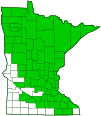dwarf raspberry
(Rubus pubescens)
Conservation • Wetland • Description • Habitat • Ecology • Use • Distribution • Taxonomy
Description |
||
Dwarf raspberry is a perennial, low-growing, non-woody subshrub. It occurs in western Europe, throughout Canada, and in the United States in the northern tier of states south to New Jersey, Colorado, and Oregon. In Minnesota it is common throughout most of the state but absent in the west-central, southwest, and south-central counties. It is found in moist to wet woodlands and meadows and in various wetlands including shrubby swamps, bogs, and fens. Dwarf raspberry rises on above-ground vegetative stems (stolons) from a root crown and a perennial, underground, horizontal stem (rhizome). The stolons are erect at first but soon recline, creep along the ground, and root at the nodes. They are slender, sparsely to moderately hairy, and 4″ to 80″ long. They do not have bristles, prickles, or glands, and are not covered with a whitish waxy bloom (glaucous). They are usually woody just at the base. Single flowering stems rise from each lower node on the stolon and from the root crown. These stems are erect, leafy, softly hairy, and herbaceous, not woody. They may be 6″ to 20″ (15 to 50 cm) tall but in Minnesota they are usually no more than 12″ (30 cm) tall. They usually have no bristles or prickles, rarely they have a few bristles. There are usually 2 to 5 leaves alternately arranged on the flowering stem. They are on hairy, ¾″ to 3″ (2 to 8 cm) long stalks (petioles) and are divided into 3 leaflets. Occasionally the two lateral leaflets are each deeply cleft into two lobes, making the leaf appear at a glance to have 5 leaflets. At the base of each petiole there is a pair of leaf-like appendages (stipules). The stipules are 3 ⁄16″ to ¾″ (5 to 20 mm) long. They may be inversely lance- or egg-shaped, widest beyond the middle; lance- or egg-shaped, widest before the middle; or elliptic, widest at the middle. The terminal leaflet is rhombic to egg-shaped, 1½″ to 3″ (4 to 8 cm) long, and ¾″ to 1½″ (2 to 4 cm) wide. It is on a short 1 ⁄16″ to ¼″ (2 to 7 mm) long stalk (petiolule). The blade is wedge-shaped at the base and tapers to a narrow (acute) point at the tip with straight or concave sides along the tip. The upper surface is dark green, the lower surface somewhat lighter. Both surfaces are hairless or sparsely hairy. The margin is deeply toothed or doubly toothed with sharp, forward-pointing teeth except at the wedge-shaped base, which is untoothed. The lateral leaflets are smaller, asymmetrically egg-shaped, rounded at the base, stalkless or nearly stalkless, but otherwise similar. In mid-May to late June 1 to 4 small flowers appear at the end of the upright stem and sometimes in the upper leaf axils. They are on long stalks (pedicels) that are moderately to densely covered with long hairs and are usually also sparsely to densely covered with stalked glands. The flowers are ¼″ to ½″ wide and are not showy. There are 5 sepals, 5 petals, and numerous stamens. The sepals are green, softly hairy, narrowly lance-shaped or narrowly triangular, ⅛″ to ¼″ (3 to 7 mm) long, and strongly bent backward. The petals are white, rarely pale pink, narrowly inversely egg-shaped or spoon-shaped, and ⅛″ to ⅜″ (4 to 10 mm) long. The stamens are shorter than the petals. The fruit is a bright red to dark red, globe-shaped, 3 ⁄16″ to 9 ⁄16″ (5 to 14 mm) in diameter aggregate of multiple drupelets. It matures late June to early August. When picked it does not separate easily from its core. |
||
Height |
||
6″ to 12″ (15 to 30 cm) |
||
Flower Color |
||
White |
||
Similar Species |
||
Habitat |
||
Moist to wet. Woodlands, shrubby swamps, bogs, fens, meadows, and stream banks. |
||
Ecology |
||
Flowering |
||
Mid-May to late June |
||
Pests and Diseases |
||
|
||
Use |
||
|
||
Distribution |
||||
|
Sources |
|||
| 2/14/2023 | ||||
Nativity |
||||
Native |
||||
Occurrence |
||||
Common and widespread |
||||
Taxonomy |
|||
| Kingdom | Plantae (Plants) | ||
| Division | Tracheophyta (Vascular Plants) | ||
| Subdivision | Spermatophytina (Seed Plants) | ||
| Class | Magnoliopsida (Dicots) | ||
Order |
Rosales (Roses, Elms, Figs, and Allies) | ||
Family |
Rosaceae (Rose) | ||
| Subfamily | Rosoideae (Brambles, Roses, Strawberries, and Allies) | ||
| Tribe | Rubeae (bramble) | ||
Genus |
Rubus (brambles) | ||
| Subgenus | Cylactis | ||
Subordinate Taxa |
|||
Two varieties have been described, Rubus pubescens var. pilosifolius and R. p. var. pubescens. The former variety is common and widespread, the latter variety is restricted to Maine, Vermont, Quebec, and Newfoundland and Labrador. Most authors do not recognize any varieties. |
|||
Synonyms |
|||
Cylactis lyncemontana Cylactis montana Cylactis pubescens Rubus aegopodioides Rubus americanus Rubus mucronatus Rubus pubescens var. pilosifolius Rubus pubescens var. pubescens Rubus pubescens var. scius Rubus saxatilis var. americanus Rubus saxatilis var. canadensis Rubus transmontanus Rubus triflorus |
|||
Common Names |
|||
dwarf raspberry dwarf red raspberry dwarf red blackberry |
|||
Glossary
Aggregate fruit
A compound fruit consisting of many separate individual fruits derived from separate ovaries in a single flower, like a raspberry or blackberry.
Axil
The upper angle where a branch, stem, leaf stalk, or vein diverges.
Drupe
A fleshy fruit with a single hard, stone-like core, like a cherry or peach.
Glaucous
Pale green or bluish gray due to a whitish, powdery or waxy film, as on a plum or a grape.
Node
The small swelling of the stem from which one or more leaves, branches, or buds originate.
Pedicel
On plants: the stalk of a single flower in a cluster of flowers. On insects: the second segment of the antennae. On Hymenoptera and Araneae: the narrow stalk connecting the thorax to the abdomen: the preferred term is petiole.
Petiole
On plants: The stalk of a leaf blade or a compound leaf that attaches it to the stem. On ants and wasps: The constricted first one or two segments of the rear part of the body.
Petiolule
The stalk of a leaflet blade on a compound leaf.
Rhizome
A horizontal, usually underground stem. It serves as a reproductive structure, producing roots below and shoots above at the nodes.
Sepal
An outer floral leaf, usually green but sometimes colored, at the base of a flower.
Stipule
A small, leaf-like, scale-like, glandular, or rarely spiny appendage found at the base of a leaf stalk, usually occurring in pairs and usually dropping soon.
Stolon
An above-ground, creeping stem that grows along the ground and produces roots and sometimes new plants at its nodes. A runner.
Subshrub
A short, perennial, herbaceous, plant that has woody stems just at the base and annual shoots at the tips. A dwarf shrub.
Visitor Photos |
|||||
Share your photo of this plant. |
|||||
| This button not working for you? Simply email us at info@MinnesotaSeasons.com. Attach one or more photos and, if you like, a caption. |
|||||
Luciearl |
|||||
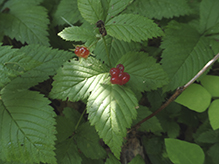 |
|||||
MinnesotaSeasons.com Photos |
|||||
Plant |
|||||
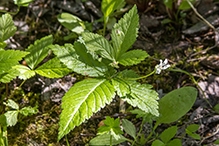 |
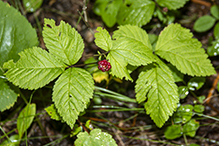 |
||||
Leaf |
|||||
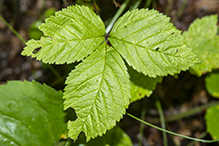 |
|||||
Fruit |
|||||
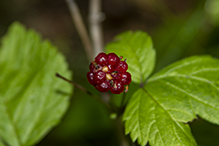 |
|||||

Slideshows |
||

Visitor Videos |
|||
Share your video of this plant. |
|||
| This button not working for you? Simply email us at info@MinnesotaSeasons.com. Attach a video, a YouTube link, or a cloud storage link. |
|||
Other Videos |
|||

Visitor Sightings |
|||||
Report a sighting of this plant. |
|||||
| This button not working for you? Simply email us at info@MinnesotaSeasons.com. Be sure to include a location. |
|||||
| Luciearl 7/7/2020 |
Location: Fairview Twp, Cass County Mistook this for a strawberry plant until the berries formed. |
 |
|||
MinnesotaSeasons.com Sightings |
|||||

Created: 12/12/2019
Last Updated:
